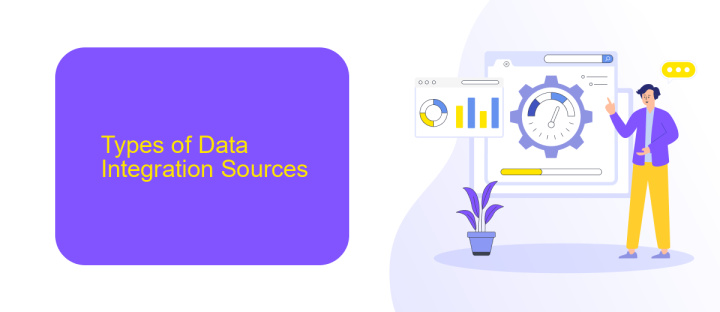Data Integration Sources
In today's data-driven world, effective data integration is crucial for businesses aiming to leverage diverse information sources. Data integration involves combining data from various sources into a unified view, enabling more comprehensive analysis and decision-making. This article explores the primary sources of data integration, highlighting their importance and the role they play in creating a cohesive data ecosystem.
Introduction
Data integration is a critical component in today's data-driven world, enabling organizations to consolidate information from various sources for comprehensive analysis and decision-making. Effective data integration helps in creating a unified view of information, which is essential for operational efficiency and strategic planning.
- Combining data from disparate sources
- Ensuring data consistency and quality
- Facilitating real-time data access and sharing
- Streamlining business processes and workflows
One of the tools that significantly simplify the process of data integration is ApiX-Drive. This service provides seamless integration capabilities, allowing users to connect different applications and automate data flows without requiring extensive technical expertise. By leveraging such platforms, organizations can ensure that their data integration processes are efficient, reliable, and scalable.
Types of Data Integration Sources

Data integration sources vary widely, encompassing databases, cloud services, APIs, and flat files. Databases like SQL and NoSQL are foundational, storing structured and semi-structured data. Cloud services such as AWS, Google Cloud, and Azure provide scalable storage and processing power, making them essential for modern data integration. APIs enable seamless data exchange between different software applications, facilitating real-time data integration. Flat files, including CSVs and Excel spreadsheets, remain useful for simple data transfers and legacy systems.
Tools like ApiX-Drive simplify the integration process by providing a user-friendly interface for connecting diverse data sources. ApiX-Drive supports various platforms, allowing businesses to automate data workflows without extensive coding. This service is particularly beneficial for linking cloud services, databases, and APIs, ensuring smooth data synchronization. By leveraging such tools, organizations can streamline their data integration efforts, enhancing efficiency and data accuracy across multiple systems.
Challenges and Considerations

Integrating data from multiple sources presents a range of challenges and considerations that organizations must address to ensure seamless and efficient operations. One of the primary challenges is data consistency, as different sources may have varying formats, structures, and standards.
- Data Quality: Ensuring the accuracy and completeness of data is crucial. Inconsistent or erroneous data can lead to flawed analysis and decision-making.
- Scalability: As the volume of data grows, the integration system must be able to scale accordingly without compromising performance.
- Security: Protecting sensitive data during integration processes is essential to prevent unauthorized access and breaches.
- Compatibility: Different data sources may use incompatible systems or protocols, necessitating the use of middleware or integration platforms like ApiX-Drive to bridge the gaps.
- Latency: Minimizing delays in data transfer is vital for real-time analytics and timely decision-making.
Using integration platforms such as ApiX-Drive can help mitigate these challenges by providing tools for data transformation, validation, and real-time synchronization. These platforms offer a user-friendly interface and robust features to streamline the integration process, ensuring that data from diverse sources can be harmonized and utilized effectively.
Best Practices

Effective data integration is crucial for businesses aiming to leverage multiple data sources for comprehensive insights. To ensure seamless integration, it's essential to follow best practices that enhance data accuracy and reliability.
Firstly, identify and understand the data sources you plan to integrate. This involves evaluating the quality, structure, and relevance of the data from each source. Establishing clear objectives for your integration project will guide you in selecting the most appropriate tools and methods.
- Use reliable integration platforms like ApiX-Drive to automate data synchronization.
- Regularly update and maintain your data sources to ensure ongoing accuracy.
- Implement robust data validation processes to detect and correct errors early.
- Ensure compliance with data privacy regulations to protect sensitive information.
By adhering to these best practices, you can create a more efficient and reliable data integration system. Tools like ApiX-Drive simplify the integration process, allowing you to focus on analyzing and utilizing your data effectively. Ultimately, a well-integrated data environment enhances decision-making and drives business growth.
Conclusion
In conclusion, effective data integration is pivotal for businesses aiming to harness the full potential of their data. By consolidating diverse data sources, organizations can achieve a holistic view of their operations, enabling more informed decision-making and streamlined processes. The challenge lies in selecting the right tools and methodologies that can seamlessly integrate disparate data sources while ensuring data quality and consistency.
Services like ApiX-Drive play a crucial role in simplifying the data integration process. With its user-friendly interface and robust capabilities, ApiX-Drive allows businesses to automate data flows between various applications and systems, reducing manual effort and minimizing errors. By leveraging such tools, organizations can focus more on deriving actionable insights from their data rather than getting bogged down by integration complexities. Ultimately, the right data integration strategy empowers businesses to stay competitive and agile in an increasingly data-driven world.
FAQ
What is data integration?
Why is data integration important for businesses?
What are common sources of data for integration?
How can I automate data integration?
What challenges might I face with data integration?
Apix-Drive is a simple and efficient system connector that will help you automate routine tasks and optimize business processes. You can save time and money, direct these resources to more important purposes. Test ApiX-Drive and make sure that this tool will relieve your employees and after 5 minutes of settings your business will start working faster.

